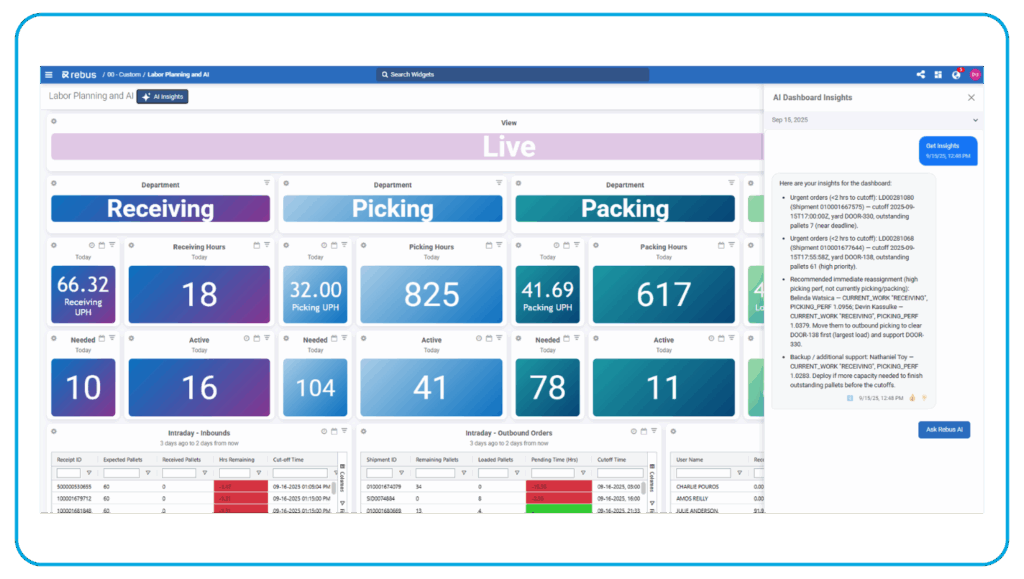Introduction
Peak season rewards precision. With promotions starting earlier and demand shifting by the hour, warehouse leaders need visibility that keeps up. End-of-day summaries can’t do that.
Real-time Inventory & Process Analytics (I&PA) connects data from your WMS, OMS, and parcel systems into one live view, giving supervisors the power to spot risk as it forms and act while there’s still time to hit service levels.
If your team is ready to run proactive, not reactive, this guide shows how to make it stick.
Table of Contents
See and solve what’s happening right now—before the shift ends.
Stay in control this holiday season with real-time Inventory & Process Analytics, ensuring you have real-time visibility into your operations. Surface what’s slowing you down, rebalance labor and slotting in minutes, and keep every order on track without waiting for reports to confirm what went wrong.
Yesterday’s View = Today’s Fire Drill
Reports built for yesterday’s world can’t keep pace with modern fulfillment. The longer you wait to see what’s happening, the more ground you lose.
- Oversells and cancellations when ATP lags reality
- Avoidable overtime when backlogs surface too late
- Markdown risk from delayed orders and missed cutoffs
- Hidden bottlenecks in putaway, picking, or pack that only appear after the shift ends
Real-time warehouse analytics expose these slowdowns as they form—so your team can fix constraints before they turn into crises.
What “Real-Time” Looks Like with I&PA
Real-time isn’t about faster data. It’s about running operations in the moment, not in hindsight.
- One connected signal. Combine WMS, OMS, and parcel events into a shared live view of orders, queue depth, throughput, and carrier cutoffs.
- Drill down in clicks. Move from network to zone to workstation to pinpoint the cause of a slowdown.
- Threshold-based alerts. Get notified when performance dips (for example, 10% below baseline for 15 minutes) so leads can rebalance without waiting for a huddle.
- Built for action. Link alerts to playbooks—shift labor, re-slot fast movers, resequence waves, or prioritize inbound based on demand.
Action, not just awareness. Tie alerts to playbooks: re-slot top movers, pull cross-trained labor, sequence inbound to unblock pick, or adjust waves before the next carrier pickup.
That’s the core value of real-time warehouse visibility: awareness that turns into action fast.
Learn how a leading healthcare logistics company improved their customer experience with real-time order visibility.

7 Real-Time Analytics Plays to Prevent Peak Surprises
Each play highlights what to watch, where to set your threshold, and what to do next. Adjust the numbers to match your own operation.
1) Live ATP Accuracy to Cut Oversells
- Watch: On-hand vs. available-to-promise by channel and node.
- Threshold: Variance >2–3% for 10 minutes.
- Act: Freeze affected SKUs, re-allocate from over-stocked nodes, or trigger a rapid cycle count.
- Why it matters: Nothing tanks CSAT like canceling an order you already “promised.”
2) Dynamic Slotting Heatmaps
- Watch: Travel time + touches for your top 50 SKUs by week.
- Threshold: Any SKU in top-decile volume not slotted within target zones.
- Act: Re-slot to shorten pick paths and reduce congestion at fast-moving bays.
- Outcome: Lower labor minutes per order; fewer pick line slowdowns.
3) Labor Rebalancing Triggers
- Watch: Units/hour by zone vs. baseline; queue depth at pick/pack.
- Threshold: −10% for 15 minutes or queue depth >X for Y minutes.
- Act: Pull cross-trained associates, open additional pack stations, or resequence waves.
- Outcome: Prevents the mid-shift cliff that leads to late trucks and OT.
4) Inbound → Putaway → Pick Synchronization
- Watch: Dock-to-stock cycle time and the share of inbound SKUs on today’s pick list.
- Threshold: Dock-to-stock > target by 20% or high-demand inbound waiting >30 minutes.
- Act: Prioritize putaway for demand-linked SKUs; stage to forward pick to unblock orders.
- Outcome: Keeps pick fueled so you’re not idling labor on empty faces.
5) Carrier Cutoff Risk Countdown
- Watch: Orders remaining vs. minutes to final pickup, by carrier/service.
- Threshold: Risk index shows <90% likelihood of clearing backlog before cutoff.
- Act: Expedite remaining waves, flex workers to pack, or switch service levels with proactive customer comms.
- Outcome: Protects on-time ship and avoids last-mile premium charges.
6) Early Warning on Returns Waves
- Watch: RMA creation rate + backlog at returns triage.
- Threshold: RMA inflow up 30% over trailing 7-day average or triage backlog > threshold.
- Act: Add a temporary returns lane, redirect associates, and pre-position packing supplies.
- Outcome: Faster restock for resaleable goods; less congestion in receiving.
7) Exception Taxonomy & Trends
- Watch: Miss-picks, shorts, damages, non-conveyables by zone/worker/SKU.
- Threshold: Spike >2σ above normal in a 60-minute window.
- Act: Investigate root causes (slotting, labeling, equipment), then deploy a targeted fix.
- Outcome: Quality issues shrink before they snowball.
All seven plays are easier when your team shares one live view. Explore how Rebus I&PA turns these signals into shift-ready dashboards and alerts.
Outcomes You Can Expect (When You Move from Static to Real-Time)
- Fewer SLA misses. Risk shows up hours earlier, not in tomorrow’s recap.
- Lower overtime. Rebalancing mid-shift trims end-of-day scramble.
- Cleaner on-time ship. Cutoff timers and backlog views keep the final mile predictable.
- Higher inventory confidence. Live ATP reduces cancellations and CS escalations.
- Fewer fire drills. Exceptions trend visibly so you fix root causes, not symptoms.
Operations stabilize, teams react faster, and everyone works from the same live truth.
Put it to Work this Week
- Choose your top metrics from the plays above and set thresholds that reflect your baseline.
- Route alerts to the people who can act within minutes (zone leads, shift managers).
- Stand up a daily “Shift Readiness” pack (backlog, cutoffs, staffing, top exceptions).
- Run a 7-day test: measure SLA performance, OT hours, and cancellations before/after.
- Codify the wins into SOPs so the improvements last beyond holiday peak.
FAQ for Surviving Peak Season
- Why are end-of-day reports risky during peak?
Because they confirm problems after you’ve missed cutoffs. Real-time visibility lets you correct course during the shift.
- What systems feed I&PA?
Typically your WMS, OMS, labor and parcel/carrier systems, plus returns/RMA where available—consolidated into one live view.
- How do I avoid alert fatigue?
Start with a small set of high-impact KPIs and set thresholds tied to action (e.g., “−10% units/hour for 15 min triggers labor move”).R
- Where do I see ROI first?
SLA protection (on-time ship), lower OT, fewer cancellations from better ATP, and faster triage on exceptions.












